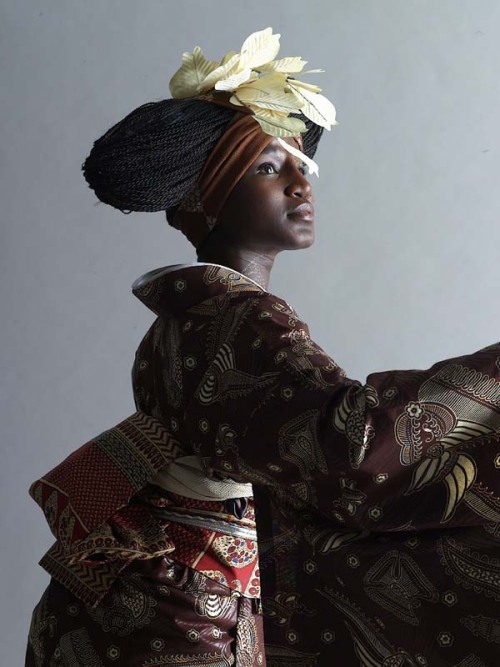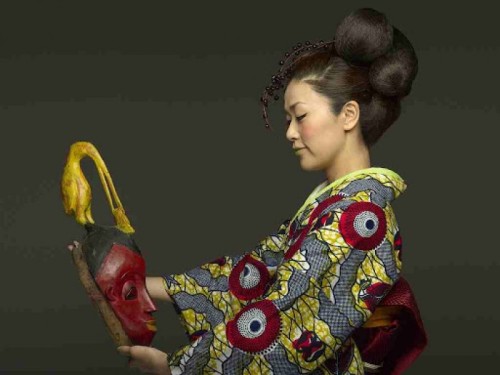#ted talks
This year I decided to get rid of 1000 things due to minimalism lifestyle. I am not really sure if I can do it but I will make my best to complete the challenge till 2021.
I feel strongly inspired by this youtube video, Marie Kondo’s programme and also I am really done with my parents cluttering our house all the time (okay, I have my share in it). Since I can remember our flat and now our cottage was full of needless things and to put it bluntly - garbage.
I want to reduce the amount of my items but I’ll try convincing my mother to do the same (my father will not listen to me at all), but my chances are really… low.
I have already made list for things to get rid of (donate, sell or throw away if needed).
I also encourage you to take part in it! Let’s declutter our homes together! Good luck!
Naif Al-Mutawa: Superheroes inspired by Islam
“What happens when you pay two monkeys unequally? Watch what happens.”
Because inequality is unbearable.
“I have cerebral palsy. I shake all the time,” Maysoon Zayid announces at the beginning of this exhilarating, hilarious talk. (Really, it’s hilarious.) “I’m like Shakira meets Muhammad Ali.” With grace and wit, the Arab-American comedian takes us on a whistle-stop tour of her adventures as an actress, stand-up comic, philanthropist and advocate for the disabled.
I feel like a smear of ink on paper. An unidentifiable version of who I used to be. And I put up this facade around everyone near me. It’s breaking me; having to act a way that everyone views me as. Im sick of it. I just want to be myself, but I don’t know who that is.
“ we [Architecture for Humanity] want to have a community where you can upload ideas, and those ideas can be tested in earthquake, in flood, in all sorts of austere environment. the reason thats important is i don’t want to wait until the next Katrina to find out if my house works. thats too late. we need to do it now. ”
Cameron Sinclair, CEO of Architecture for Humanity in his Ted Talks speech
Post link
“ …architecture is a space that doesn’t always follow us like a dog that has been trained to follow us, but moves ahead into directions of demonstrating other possibilities, other experience that have never been…”
Architect Daniel Libeskind on Ted Talks
The Big TED
Upstairs at the convention center, a view of Vancouver Harbor
Back from Vancouver, where TED hosted its first flagship conference since 2019, and what an event it was. We were greeted by anti-vaxxers who have it out for Bill Gates, one of this year’s speakers.
Nearly 2,000 participants took part from all over the world, dozens of speakers and performances enchanted, empowered and enlightened us,…

Livin’ That Multihyphenate Life, Finally
New gig, who dis?
Starting today I’ll be in available in your feeds every weekday, hosting the daily TED talk podcast, which is the fittingly-named TED Talks Daily. It’s one of America’s top 20 podcasts and downloaded a million times a day, all over the world. Not only do I love working with the good folks at TED already and love being able to host this from anywhere with an internet connection,…
Launched last month, Wafrica — Africa plus wa for Japan — has unveiled a range of kimono handcrafted in an array of African cotton fabrics that would seem to be a million miles from the subtle silks more commonly associated with traditional Japanese dress. Yet despite the orange comets and flashes of lightning tearing across a moss-green background, and the tribal swirls in colors that recall the sun-drenched African soil, the prints blend seamlessly into the kimono form before they surprise Japanese shoppers with their foreign origin.
The cultural cocktail is the brainchild of Serge Mouangue, a Tokyo-based concept- car designer for Nissan, who joined forces with Kururi, a Tokyo-based kimono- maker, to produce the traditional Japanese attire in 18 African prints sourced in markets from Nigeria to Senegal.
[source]
Serge Mouange introduces the WAfrica concept and kimono (Fashion show)
Le kimono Africain: Serge Mouangue TED talks
Post link
A really interesting TedTalk explaining why mental health care is important and why we need to #endthestigma, especially during a pandemic (even though the video is pre- COVID).
If you are struggling with mental health, know that I understand and I am here with you. It has been hell at times, but you are not alone. ❤️
Hey guys so I’m really thinking about making a new account and moving on from this one cuz its really cluttered tbh. I might reblog recent artworks of mine to that account or smth? Plus I want to properly incorporate my own original art there rather than mostly being known as a fan artist
Thoughts??
Review of TED Talk artist, Antony Gormley
Gormley’s talk was based on combining the theoretical aspects of space, and time with the physical dimensions of the corporeal realm. He explains how it is continuous and everlasting, existing without boundaries both internally and to the exterior of the human form, using it as a catalyst for reaction and interaction.
Gormley claims that his interests lie within creating a subject and collective space that usually only resides within the darkness of the human body, specifically the mind. He views this as a place of imagination and of potential, a place in which there are no ‘things’ in this 'dimensionless, limitless, indeed endless’ space. Gormley states that the most profound quality is that is is objectless, which is in direct contrast to the very nature of sculpture as it produces a proposition of materials and scale, whereas paradoxically, this space does not have any of these. It is not inhabited, influenced or touched by foreign entities.
However, as a sculptor, he works directly with real places that have intimate elemental features that pose the question 'can the dark void of the mind be mapped?’ Best shown in ’Aperture VII’ 2010 as it clearly marks out the fundamentals of the human form, but without giving it any true weight or physicality.
(I found this a fascinating notion for a sculptor, and didn’t think that his lecture would be as philosophical and thought provoking as it was.)
Using the figure as a basis, a physicality in which his metaphysical void exists in the mind Gormley claims that the body is its boundaries, its limit in existence, making a formless entity visible and substantial. He did this through the use of an external membrane, his piece, 'Learning to See' (1988-98). A lead capsule that encases the space where Gormley once stood. It’s name originated due to the purpose; an object that sees reflectively and speaks about that connection with the darkness of the interior of the body, demonstrated with the darkness that resides within the capsule.
To develop this idea, Gormley now placed the negative cast against a natural element, the horizon ’Another Place’ (1997). The piece is looking out beyond the horizon, as these surrogate bodies question the relationship between the natural and the unnatural, the internal and the external; a relation with the real body and the infinite body. It raises the idea of the interior darkness and its bodily limit, stretching out to the horizon and whatever is beyond it.
’Blind Light’ (2007) consists of light, water vapor and vast openness which materialistically and aesthetically is contradictory to the encapsulated void of the figures previously demonstrated in Gormley’s work. However, this piece is a better, clearer representation of the ideas Gormley spoke of previously.
“You disappear, to others and to the self, visually and emotionally, you are now consciousness without object, you are the dark void that could only possibly exist internally, now it is external, it is real, freed from the dimensional and measured, ambient environment, the space is actually filled with people, disembodied voices when others approach your own body that they appear to be representations, when they appear close to the edge of the box, they are representations, representations in which the viewers become the viewed.” - Gormley
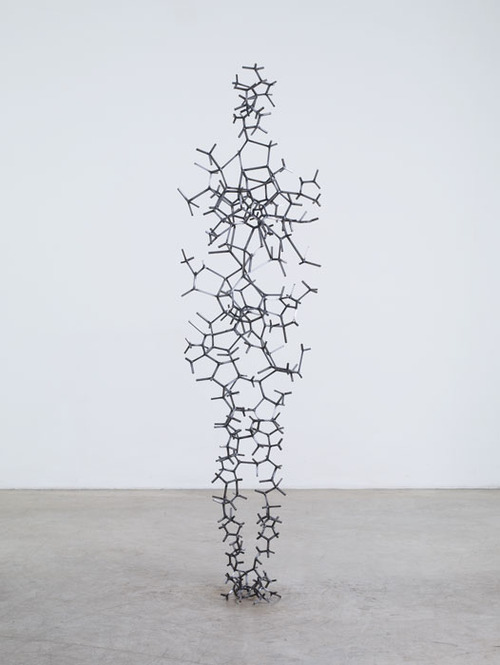
’Aperture VII' (2010)
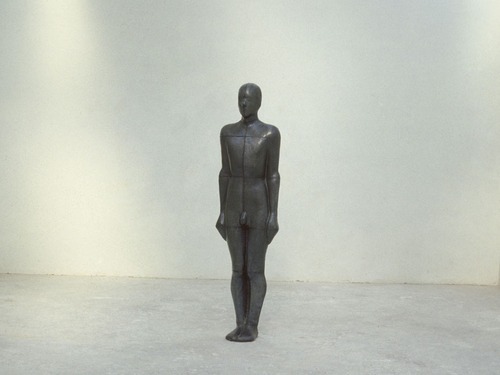
'Learning to See' (1988-93)

'Another Place’ (1997)
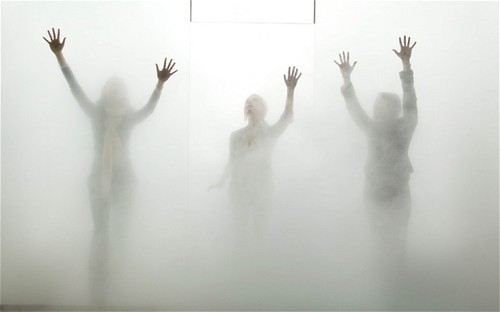
'Blind Light’ (2007)
Reviewed by, Katie Varey
12/1/2014
Video can be viewed at:
Review of TED Talk speaker, Ursus Wehrli.
Wehrli’s lecture was based on his obsession with re-constructing famous pieces of artwork as he considers them ‘untidy’. He does this in such a way that completely alters the perception of the art and in turn makes a new meaning for itself.
Wehrli’s style was very tongue-in-cheek. It is clear that his work is based on humour by challenging what is to be considered as aesthetic value in a painting; especially when spatial awareness is concerned. He states that art has aesthetic 'clutter’ that in his opinon is uncomfortable to view or contemplate, and therefore the piece can be re-arranged and as a result, be returned to its 'original state’.
It is clear that Wehrli is aware of the linear structures within art, and with this he intends to re-organise the space within the frame so that the information that makes up the painting is clearly accessed. By this, he is not only re-arranging the composition, but is also drastically changing the aesthetic value, altering the purpose and creating another veil of meaning. This contribution not only mocks the visual content, but the concept and perception of the piece.
Artists whom he was most inspired by were, Vincent van Gogh, Jasper Johns, Donald Baechler, Paul Klee, Jackson Pollock and Rene Magritte, who’s work he continued to simplify and taunt.
“Its a bit more structured, it’s not too bad, this is Jasper Johns we can see he was practising with his ruler but I think it could benefit from some more discipline.” - Wehrli
(below) Rene Magritte, Jackson Pollock and Jasper Johns work have all been simplified and made into a more logical composition.



As for the actual presentation, Wehrli was clear and easy to understand (even with a heavy Swedish accent). He didn’t use a PowerPoint format to communicate his work, rather display easels and boards, which gave it more of a personal touch as it was not done through technological means.
Although the subject matter had no particular relevance to my own studio practice, I did find the talk enjoyable and less dictating than the others I have attended or reviewed.
Reviewed by, Katie Varey
12/1/2014
Video can be viewed at:
Review of TED Talk speaker, Zoya Jiwa
Jiwa’s lecture was to explain how the media promotes the ideal body image into society by comparing real bodies to those of artificial dolls and toys, namely the Barbie doll. Jiwa reflected upon these themes with a personal insight as she spoke of her own experience with negative emotions of her own body image.
Jiwa began to talk about when she was a teenager and how she compared her physical appearance to others, claiming that her esteem was lowered because she wasn’t perfect or beautiful enough in society. She stated that ideals of beauty vary depending on the cultural environment that a person grows up in, however rather than going off on a tangent (saying how it is different in other countries and cultures) she related it to how the USA media continuously bombards its audience with the dominant hegemony that being beautiful, flawless and thin also equates to success and happiness.
Jiwa then goes onto explore how the media uses such imagery to its benefit to gain capital profit, making billions of dollars by simply mass producing a ‘look’ that isn’t realistic.
“Why can’t I look like that?” - Jiwa
She spoke of her personal realisation that it wasn’t possible because what we view in magazines isnt real. Jiwa makes a point of comparing Dove 'Real Beauty’ campaign project’s images, both the Photoshop end product and the genuine, natural photograph of the model before she was edited in the computer.
Jiwa ended her talk on a quote by actress Judy Garland: “Always be a first rate version of yourself rather than a second rate version of someone else.” This sums up the driving concept behind what Jiwa was trying to communicate, her own ideas on beauty, that trying to be someone else is futile and ultimately wrong.
I enjoyed the lecture as although it was brief, it was clear and overall, well done. She actively engaged the audience by posing questions about how they view beauty, and how they visualised it, which broke up the speech and made even me question what I saw as beauty.
For myself, I found the fact that she used quotes, facts and statistics useful as for my project, body image is significantly tied to the exaggeration and importance of numbers.
Reviewed by, Katie Varey
12/1/2014
Video can be viewed at:
Review of TED Talk artist, Alexa Meade.
Meade is an American artist who became famous for her paintings that were produced on live human models. Her innovative style challenges traditional painting methodologies, and forces the audience to question what a painting is and how important the subject within the image is.
Meade also takes the concept of ‘trompe-l'oeil’ (the process of making a three dimensional scene appear to be two dimensional) in her work as she applies the paint to the model and then photographs the finished piece.
“I can take a photograph from any angle and the scene will look 2-D.” - Meade
Meade states that her inspiration for this idea came from observing shadows, and a fascination with the absence of light and trying to preserve the shadow, trace it with the use of acrylic paint as a medium. She found it intriguing that the paint would not actually be noticable until the light shifted, and the object created a new shadow. I found it frustrating that Meade did not explain her reason for using acrylic paint, so I presume it is because of the quick drying and practical qualities.
Her notion developed to include how shadows are temporary, and have a temperament for movement, that they are never static. This constant motion is dependant on light and an object to create a shadow. Meade commented that rather than painting the shadow on a canvas, due to the flatness and immobile qualities, she would transfer the life onto her models and paint them instead.
An interesting development that this light and space took on was that her subjects were allowed to walk and go on with their daily lives. Meade actively followed the models, photographing her walking canvases as they interacted with the public.
Meade collaborated with artist Sheila Vand, using her as a subject within her imagery. By painting Vand semi-submerged in a bath of milk, Meade documented the 'unexpected’ results as her limbs became hidden and blended with the opaque backdrop. In my own opinion, I agree with Meade that this series of work entitled 'Activate’was more symbolic and an elegant progression of ideas.
For me, I can see my work involving aspects of painting practice again and not just representing my ideas through sculpture. By studying Meade’s style I can see how experimentation and use of the form can be a valid and ignorable asset.
“Turning people into paintings and painting on people in a pool of milk, you find the strange in the familiar. But to get this, you must look at what is below the surface, hiding in the shadows, looking beyond what has already been highlighted.” - Meade
Reviewed by Katie Varey,
11/1/2014
The video can be viewed at:
because (sometimes) they motivate me
How language shapes the way we think | Lera Boroditsky
The secrets of learning a new language | Lýdia Machová
How to learn any language in six months | Chris Lonsdale | TEDxLingnanUniversity
Learning a language? Speak it like you’re playing a video game | Marianna Pascal | TEDxPenangRoad
Why We Struggle Learning Languages | Gabriel Wyner | TEDxNewBedford
5 techniques to speak any language | Sid Efromovich | TEDxUpperEastSide
Breaking the language barrier | Tim Doner | TEDxTeen 2014
How to learn any language easily | Matthew Youlden | TEDxClapham
The Irish Language and Beauty | Dónall Ó Héalaí | TEDxBerkeley
How to Talk Like a Native Speaker | Marc Green | TEDxHeidelberg
How the language you speak affects your thoughts
Hacking Language Learning: Dr. Conor Quinn at TEDxDirigo
How learning German taught me the link between maths and poetry | Harry Baker | TEDxVienna
We'r Needin tae Talk Aboot Wir Language | Michael Dempster | TEDxInverness
One Simple Method to Learn Any Language | Scott Young & Vat Jaiswal | TEDxEastsidePrep
Learning a Second Language | Shinyoung Grace Kim | TEDxYouth@AISR
Let me know if I missed your favourite!

![“ we [Architecture for Humanity] want to have a community where you can upload ideas, and thos “ we [Architecture for Humanity] want to have a community where you can upload ideas, and thos](https://64.media.tumblr.com/f137de1a5eee052b1f69f2448c0b997c/tumblr_mnwbrwtyQo1r4q190o1_500.jpg)
